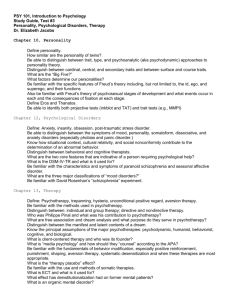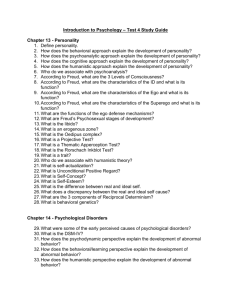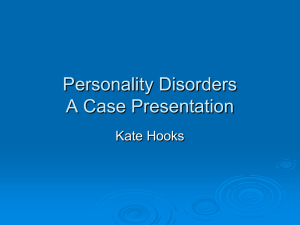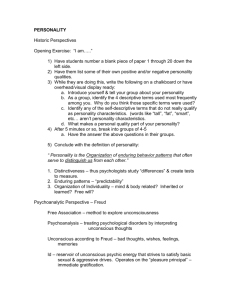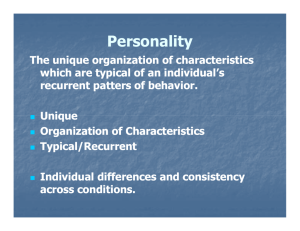Final Exam Study Key for Test 4
advertisement
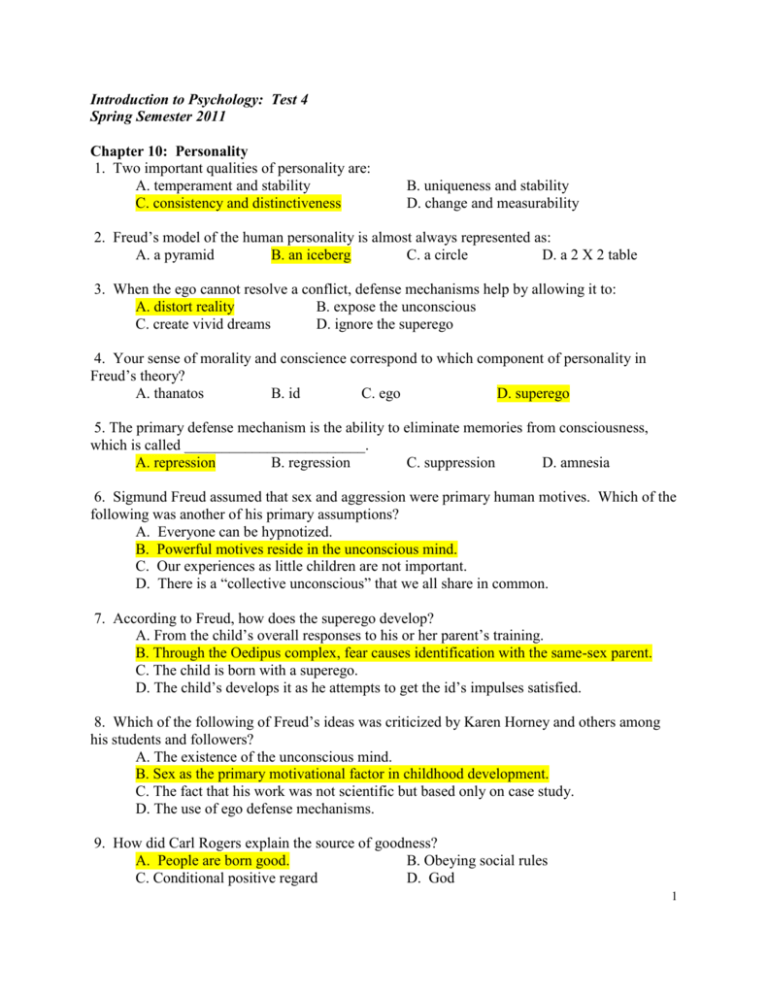
Introduction to Psychology: Test 4 Spring Semester 2011 Chapter 10: Personality 1. Two important qualities of personality are: A. temperament and stability C. consistency and distinctiveness B. uniqueness and stability D. change and measurability 2. Freud’s model of the human personality is almost always represented as: A. a pyramid B. an iceberg C. a circle D. a 2 X 2 table 3. When the ego cannot resolve a conflict, defense mechanisms help by allowing it to: A. distort reality B. expose the unconscious C. create vivid dreams D. ignore the superego 4. Your sense of morality and conscience correspond to which component of personality in Freud’s theory? A. thanatos B. id C. ego D. superego 5. The primary defense mechanism is the ability to eliminate memories from consciousness, which is called ________________________. A. repression B. regression C. suppression D. amnesia 6. Sigmund Freud assumed that sex and aggression were primary human motives. Which of the following was another of his primary assumptions? A. Everyone can be hypnotized. B. Powerful motives reside in the unconscious mind. C. Our experiences as little children are not important. D. There is a “collective unconscious” that we all share in common. 7. According to Freud, how does the superego develop? A. From the child’s overall responses to his or her parent’s training. B. Through the Oedipus complex, fear causes identification with the same-sex parent. C. The child is born with a superego. D. The child’s develops it as he attempts to get the id’s impulses satisfied. 8. Which of the following of Freud’s ideas was criticized by Karen Horney and others among his students and followers? A. The existence of the unconscious mind. B. Sex as the primary motivational factor in childhood development. C. The fact that his work was not scientific but based only on case study. D. The use of ego defense mechanisms. 9. How did Carl Rogers explain the source of goodness? A. People are born good. B. Obeying social rules C. Conditional positive regard D. God 1 10. What is a person’s self-concept? A. the person they would like to be B. a person’s evaluation of his or her own worth C. all his or her feelings and thoughts about him/herself D. a person’s idea of his or her abilities and personality 11. What was the chief motive of life according to Abraham Maslow? A. self-esteem B. self-actualization C. doing good D. resolving ego conflicts 12. Which of the following is a criticism of both psychoanalytic and humanistic theory? A. It is too negative. B. It has not been scientifically tested. C. Its concepts are too vague. D. It fails to account for human evil. 13. What did Carl Rogers believe was needed to achieve human potential? A. guidance & discipline B. empathy C. unconditional positive regard D. resolving of unconscious conflicts 14. Freud explained glove anesthesia as: A. the result of overusing the hand. C. something the mind did to the body. B. a degenerative nervous condition D. a symptom of an anxiety disorder. 15. The belief that personality emerges from ongoing mutual interactions among people’s cognitions and actions and their environment is: A. self-efficacy B. reciprocal determinism C. trait theory D. humanism 16. Sometimes when a person feels anxious, he or she retreats mentally into an earlier time of life where he or she felt happier and more comfortable. For example, when four-year-old Billy‘s little sister was born and “stole” all his parents’ attention, he went back to sucking his thumb and carrying his blanket like he did when he was two. This is an example of: A. regression B. reaction formation C. repression D. rationalization 17. Harvey was really attracted to Sarah at work, but he loved his wife and did not want to be unfaithful to her. To deal with his feelings for Sarah, he told everybody that he disliked her intensely and wanted to avoid working with her as much as possible. This is: A. displacement B. reaction formation C. repression D. rationalization 18. Of the big five personality traits, this one would best be described as getting along well with other people. The person with a high score on this trait likes to help others, trusts others, and generally goes long with what others choose to do. A. conscientiousness B. extraversion C. agreeableness D. openness Chapter 11: Psychological Disorders 19. To be diagnosed as psychologically disordered, a behavior pattern must: A. only violate cultural norms B. only be maladaptive C. violate norms & be maladaptive D. be atypical, maladaptive & disturbing 2 20. The fear of experiencing a panic attack is a serious problem for a person with: A. social phobia B. OCD C. panic disorder D. schizophrenia 21. In which category of mental disorders do con men and serial killers usually fall? A. dissociative identity B. bipolar C. antisocial personality D. schizophrenia Match the psychological perspective with the description of the cause(s) of mental disorder. A. psychodynamic B. behavioral C. cognitive D. biological E. sociocultural C 22. The root cause of mental illness is ineffective or inaccurate thinking. E 23. Mental illness is the product of broad social and cultural forces. D 24. Disordered behavior is caused by genetics, hormones, or chemical activity in the brain. A 25. Disordered behavior is controlled by unconscious forces shaped by childhood experiences. B 26. Disordered behavior is the result of learning and identifiable environmental factors. 27. _____________ disorders are a category of disorders in which extreme anxiety is the main diagnostic feature and causes significant disruptions in functioning. A. Mood B. Anxiety C. Personality D. Psychotic 28. Ravi is worried about losing his teeth at an early age, even though he has no particular reason to believe that he will suffer early tooth loss. He brushes his teeth 10 times a day. Each time, he uses exactly 83 strokes up and 83 strokes down. After he eats, he must brush twice with two different brands of toothpaste. Ravi suffers from a (n) _____________ disorder. A. phobic B. obsessive-compulsive C. bipolar D. personality 29. A person who is temporarily living in “fast forward” – euphoric, hyperactive, and wildly optimistic, may be experiencing: A. a delusion B. hallucinations C. a manic episode D. PTSD 30. Norby, a 19-year-old college freshman, has missed almost all his classes during the past month since his girlfriend broke up with him. He spends most of his time in bed, frequently not even bothering to get dressed or eat meals. He thinks his whole life has been a failure and blames himself for being a social misfit. He is most likely suffering from which disorder? A. major depression B. generalized anxiety C. obsessive-compulsive D. bipolar disorder 3 31. Sam heard a voice telling him to warn other people that eating fish is harmful. His thoughts and speech are often fragmented and hard to understand. In addition, he has an unreasonable fear that somebody is “out to get him.” What psychological disorder does this represent? A. schizophrenia B. phobic disorder C. antisocial personality D. mood swings Chapter 11: Treatment 32. Psychotherapy is done by: A. clinical psychologists only C. A & B above only B. psychiatrists only D. A & B above and others 33. If a person undergoes therapy in which they are given relaxation training, a getaway scene, an anxiety hierarchy, and an opportunity to practice, what type of disorder is probably being treated? A. OCD B. phobia C. personality disorder D. dissociative amnesia 34. What neurotransmitter do antipsychotic drugs target? A. dopamine B. serotonin C. GABA D. endorphins 35. When choosing a therapist, make sure that you and he or she agree on: A. the type of his/her training B. the best type of therapy C. life values. D. what your problem is 36. What is the most common undesirable side effect of electroconvulsive therapy (ECT)? A. hallucinations B. retrograde amnesia C. loss of muscle tone D. increased anxiety 37. Lithium is used to treat: A. bipolar disorder C. antisocial personality disorder B. major depression D. obsessive-compulsive disorder 38. What are antidepressant drugs used to treat in addition to depression? A. schizophrenia B. anxiety disorders C. personality disorders D. Dissociative disorders 39. Carolyn’s therapist told her to relax and spontaneously say whatever thoughts or images came to her mind. Her therapist was using the psychoanalytic technique known as: A. transference. B. free association. C. dream interpretation. D. conditional positive regard. 40. In some psychodynamic therapy, the patient puts feelings developed in an old conflict onto the therapist. This process is known as: A. resistance B. free association C. transference D. empathy 41. The goal of cognitive therapy is: A. gaining insight into the unconscious C. relearning maladaptive behaviors B. correcting irrational thought processes D. gaining understanding of the self-concept 4 42. What is the preferred method of therapy for phobias? A. Gestalt B. cognitive-behavioral C. psychoanalysis D. group therapy 43. The focus of couples and family therapy is: A. a common or shared problem in the group. B. group relationship & communication patterns. C. the mental problem of one member of the group. D. none of the above Chapter 13: Social Psychology 44. In the 1950s, Solomon Asch asked people to identify which of three comparison lines was identical to a standard line. His research was designed to study: A. the fundamental attribution error. B. social facilitation. C. deindividuation. D. conformity. Match the following terms with their definitions or descriptions. A. mere exposure B. attribution C. conformity D. low elaboration E. impression formation D 45. Experiencing a change in attitude even though the message is not understood. A 46. Automatic increases the liking or positivity of a person or object as it is repeatedly encountered or experienced. C 47. Agreeing with or going along with what a crowd is doing merely to avoid being different or expressing a contrary opinion. B 48. The process by which we use information to make inferences about the causes of behavior. E 49. The process of combining various information about a person into an overall judgment. 50. To make an external attribution is to: A. emphasize the influence of the situation in causing a behavior. B. emphasize the influence of personality in causing behavior. C. fail to understand how attitudes cause behavior. D. fail to realize that behavior can change attitudes. 51. Stanley Milgram's classic "shock experiment" in the 1960s examined: A. blind obedience to authority B. conformity to social norms C. compliance to others' requests D. altruistic helping behavior 5 52. What is cognitive dissonance? A. mental discomfort experienced when we feel confused B. a deliberate decision to keep two contradictory attitudes C. mental discomfort experienced due to contradictory thoughts & behaviors D. an attempt to think up a reasonable excuse for our behavior 53. What seems to be the best explanation for the finding that so many people were willing to go all the way to 450 volts in the Milgram experiment? A. They disliked the learner. B. They just did not care. C. It was a challenge D. They absolved themselves of responsibility. 54. When participants in the Milgram experiment were allowed another “teacher” participant to refuse to go all the way to 450 volts, what was the effect on their later behavior? A. They were more likely to go to 450 volts. B. They were more likely to refuse to go to 450 volts. C. There was no effect. D. They refused to participate in the experiment. 6
